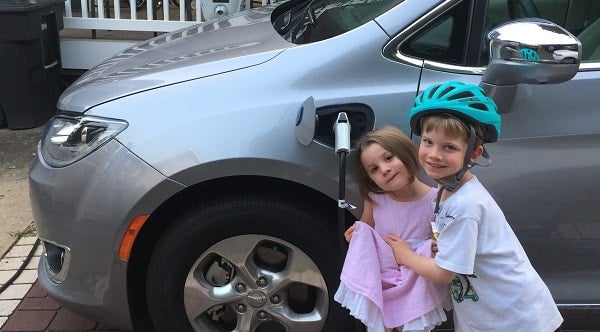First Level 2 EV charger installed as part of the Arlington Solar + EV Charging Co-op


In August of 2018, the Bruno family of Arlington, Virginia, installed a Level 2 electric vehicle (EV) charger as part of the Arlington Solar + EV Charging Co-op. This is the first co-op to include the option of installing a Level 2 EV charger, which charge three to six times faster than a standard issue Level 1 charger, along with the traditional solar installations through the co-op. While the Brunos decided to only install an EV charger through the group, many are taking advantage of the opportunity to install solar at the same time.
The whole family enjoyed the installation process and have continued to enjoy the benefits of the faster car charging since. Mr. Bruno is happy because the installation went smoothly; Mrs. Bruno is happy because the installers made sure the charger blends in with the nearby front porch; and the kids like to take turns for who gets to plug in the hybrid Chrysler Pacifica whenever they get home! Thanks to the Level 2 charger, the minivan charges in less than two hours—a huge reduction compared with more than 14 hours with the standard charger. Since the installation of the charger, the family has already traveled hundreds of miles without gas!
The Brunos enjoyed the co-op experience and recommend it to anyone interested in going solar or looking to speed up home charging for their EV. We asked Michael Bruno a few questions about his EV and his experience with the Arlington Solar + EV Charging Co-op.
Tell us about your electric vehicle and your decision to purchase an EV.
We have a 2018 hybrid Chrysler Pacifica. (Editor’s note the Chrysler Pacifica is plug in hybrid with approximately 33 miles of all electric range before being powered by a gas engine) Going hybrid was how we rationalized trading up in size from our beloved-but-decaying 2002 Toyota Echo. Knowing that our new car—and most likely any future new car from now on—would be plug-in, we were willing to go the extra mile and get an EV charger installed. Nearly all our trips are on electricity.

Can you tell us a little bit about your Level 2 charger and how you decided to install it through the Arlington EV Solar co-op.
The Siemens Versicharge was what the co-op offered, and after doing a brief amount of my own snooping online, I could tell it was one of the major offerings on the market. I did not want to go with a company or piece of equipment that had little or no track record. One of my concerns in doing all of this was to make sure I “future-proofed” to some degree, so that I wasn’t destined to come back soon and have to pay to redo anything.
What was the installation process like?
Installation came in two phases: initial on-site review, then installation a few weeks later. The initial review was excellent for laying out the options for installation and deciding a best plan of action. This included running a 240v line out of the circuit box inside and across our crawlspace, through a new hole in the foundation and out to the EV charger. (Editor’s note: a level 2 charger requires a 240 Volt electric service similar to a clothes dryer or electric range)
The actual installation itself went even better than expected, although some of that came from a bit of luck: we happened to have a dark 240v line ready to go out of the circuit box! Still, the rest of the installation went according to plan, including drilling the hole in the foundation, and as anyone who has ever done a home project knows, that’s all you can really ask for.
What would you tell someone interested in purchasing an EV but doesn’t know where to start—or may be concerned about costs?
I did a modicum of research online about EV charger and installation costs, so I was ready with a price range in my head when I joined the coop. Literally I just Googled, just to get a mental framework. When I got the co-op proposal I jumped on it because the cost was better than expected. As for increased electrical costs, we have not seen a surge yet in our bill, although we would need to go a few months to really see the difference (we do not have solar panels and we are not on any special electric company plan, as Dominion’s pilot program is set to close in November). But I have certainly noticed a reduction in our gas spending. (Editor’s note: switching to electricity to fuel vehicles can cut gas spending by more than half)
Did you learn anything through the co-op/ EV charger installation process that surprised you?
Honestly, what surprised me the most is I thought the whole thing would cost more to install.
